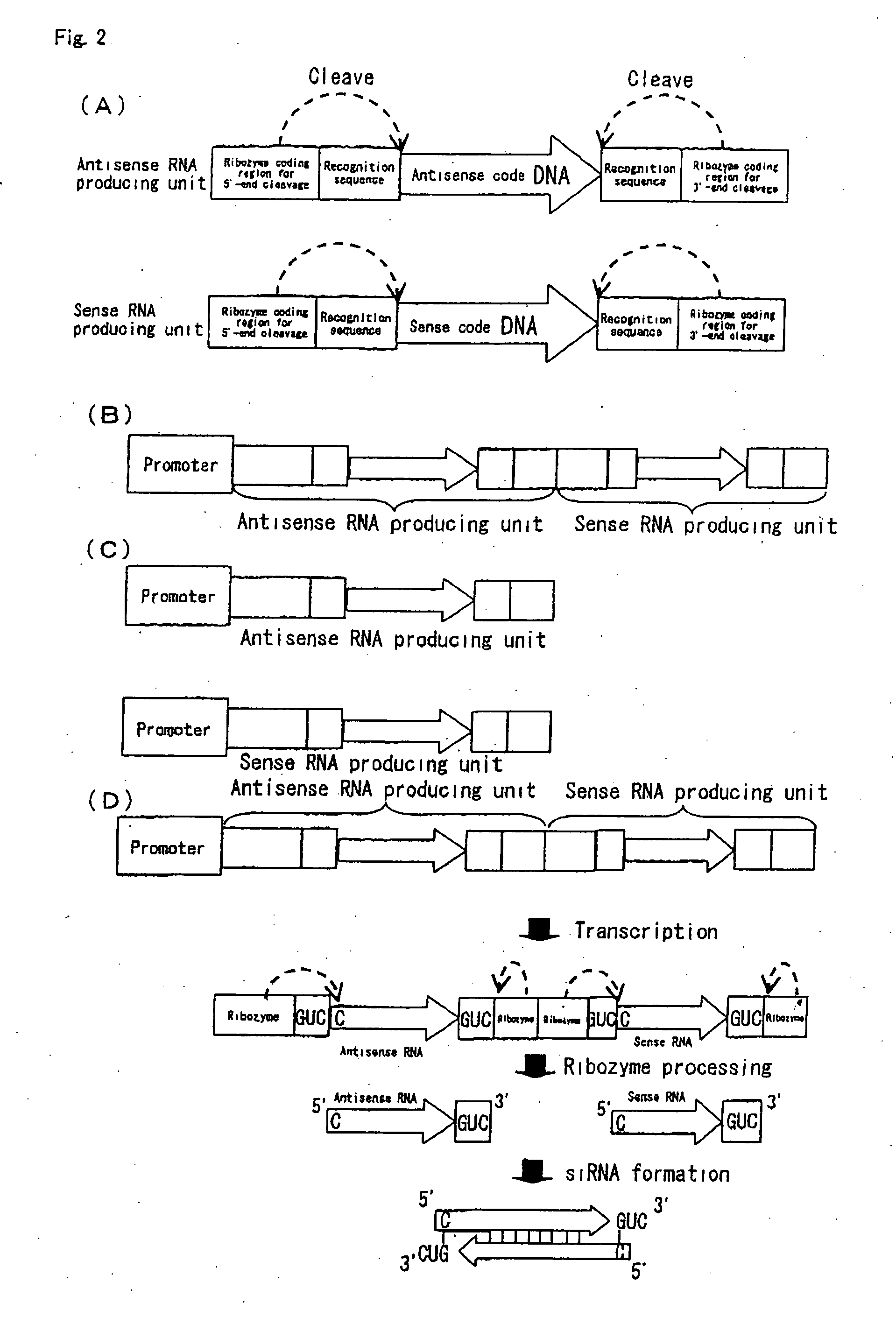siRNA expression system and method for producing functional gene knock-down cell using the system
a technology of sirna and expression system, which is applied in the field of in vivo sirna expression system, can solve the problems of increasing the physical load of patients, not being observed, and not having sufficient stability, and achieves the effect of reducing the gene silencing efficiency of sirna
- Summary
- Abstract
- Description
- Claims
- Application Information
AI Technical Summary
Benefits of technology
Problems solved by technology
Method used
Image
Examples
example 1
RNAi Induction by Using siRNA Expression Vector
[0158] Whether the siRNA expression vector can silence the target gene coding for the exogenous hygromycin / EGFP fusion protein was examined.
[0159] The Hygromycin / EGFP expression vector (pHygEGFP), and DsRed expression vector (pDsRed2) that is an internal control were purchased from Clontech. The siRNA expression vector was constructed using the plasmid pU6 carrying the human U6 promoter (Ohkawa, J. & Taira, K. Control of the functional activity of an antisense RNA by a tetracycline-responsive derivative of the human U6 snRNA promoter. Hum Gene Ther. 11, 577-585 (2000)). Fragments containing DNAs coding for portions of hygromycin / EGFP sense and antisense RNAs were synthesized with a DNA synthesizer, and subcloned immediately downstream of the U6 promoter in pU6. To insert these synthetic fragments downstream of the U6 promoter in pU6, a BspMI recognition site was provided downstream of the U6 promoter and another BspM1 site was provide...
example 2
Quantification of Gene Silencing Activity of siRNA Expression Vector
[0164] In order to quantify RNAi effects, the gene expression silencing activity of siRNA directed against genes of firefly and sea pansy luciferases as the other reporter gene was analyzed as follows.
[0165] HeLa S3 and COS 7 cells were cultured in Dulbecco's modified Eagle's medium supplemented with 10% fetal bovine serum. The respective cultured cells (3×104 cells / well) were placed in each well of 48-well plates. To conduct luciferase reporter analysis, the RSV-sea pansy luciferase expression vector (pRL-RSV)15 (30 ng), firefly luciferase expression vector pGL3 (Promega) (30 ng), and various amounts of siRNA expression vectors directed against firefly or sea pansy luciferase transcriptional product were co-transfected into cells in each well by the lipofection method using Lipofectamine 2000 (Life Technologies).
[0166] Results of luciferase analysis in HeLa S3 cells are shown in FIG. 4. FIG. 4A represents result...
example 3
Target Site-Dependent Gene Silencing
[0167] Next, it was examined whether siRNA expression vectors directed against different target-sites in the same transcriptional product have different gene silencing effects or not. In this analysis, each of siRNA expression vectors directed against four different target sites on the firefly luciferase transcriptional product was co-transfected together with the firefly luciferase expression vector, and sea pansy luciferase expression vector as an internal control into HeLa S3 cells under similar conditions as in Example 2. Sequences of sense and antisense code DNAs in siRNA expression vectors directed. against these four different target sites are set forth below:
firefly luciferasesite O sense strand:5′-GCTATGAAACGATATGGGC-3′;(SEQ ID NO: 1)site O antisense strand:5′-GCCCATATCGTTTCATAGC-3′;(SEQ ID NO: 2)site A sense strand:5′-GTTCGTCACATCTCATCTAC-3′;(SEQ ID NO: 3)site A antisense strand:5′-GTAGATGAGATGTGACGAA-3′;(SEQ ID NO: 4)site B sense str...
PUM
| Property | Measurement | Unit |
|---|---|---|
| pH | aaaaa | aaaaa |
| pH | aaaaa | aaaaa |
| temperature | aaaaa | aaaaa |
Abstract
Description
Claims
Application Information
 Login to View More
Login to View More - R&D
- Intellectual Property
- Life Sciences
- Materials
- Tech Scout
- Unparalleled Data Quality
- Higher Quality Content
- 60% Fewer Hallucinations
Browse by: Latest US Patents, China's latest patents, Technical Efficacy Thesaurus, Application Domain, Technology Topic, Popular Technical Reports.
© 2025 PatSnap. All rights reserved.Legal|Privacy policy|Modern Slavery Act Transparency Statement|Sitemap|About US| Contact US: help@patsnap.com



